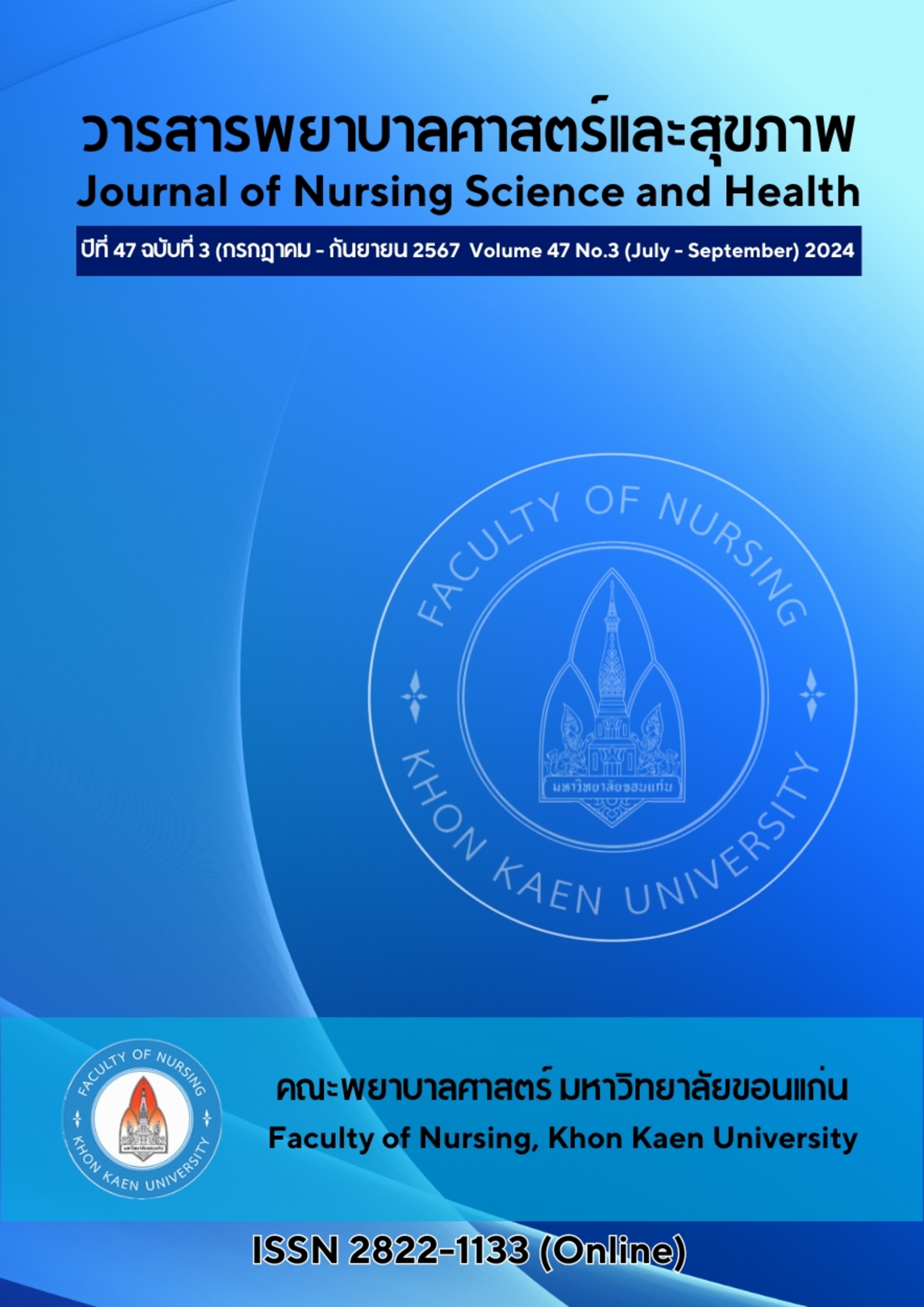การแปลและการตรวจสอบความเชื่อมั่นของแบบวัดความไม่สุขสบาย จากอาการกระหายน้ำจากการผ่าตัด ฉบับภาษาไทย
คำสำคัญ:
ความเชื่อมั่น, อาการกระหายน้ำ, กระบวนการแปล, ความตรงบทคัดย่อ
อาการกระหายน้ำพบได้บ่อยในผู้ป่วยหลังผ่าตัด และทำให้เกิดความไม่สุขสบาย เครื่องมือมาตรฐานสำหรับประเมินอาการดังกล่าว จะช่วยในการประเมินปัญหาและเพิ่มประสิทธิภาพในการดูแลผู้ป่วยหลังผ่าตัดได้ บทความนี้ มีวัตถุประสงค์เพื่อแปลแบบวัดความไม่สุขสบายจากอาการกระหายน้ำจากการผ่าตัด (The perioperative thirst discomfort scale: PTDS) จากฉบับภาษาอังกฤษเป็นฉบับภาษาไทย และตรวจสอบความน่าเชื่อถือของแบบวัดฯ ฉบับภาษาไทย โดยในการศึกษาครั้งนี้ ได้นำกระบวนการแปลและตรวจสอบคุณภาพเครื่องมือวิจัยขององค์การอนามัยโลกมาใช้กระบวนการแปล ประกอบด้วย 1) การแปลเครื่องมือจากภาษาอังกฤษเป็นภาษาไทย 2) การตรวจสอบเครื่องมือวิจัยฉบับแปลโดยกลุ่มผู้เชี่ยวชาญ 3) การทดสอบเครื่องมือในผู้ใช้ภาษาไทยเพียงภาษาเดียว 4) การแปลย้อนกลับจากภาษาไทยเป็นภาษาอังกฤษ 5) การตรวจสอบความเท่าเทียมกันของเครื่องมือ โดยผู้พัฒนาเครื่องมือต้นฉบับ
ผลการแปลพบว่า แบบวัดความไม่สุขสบายจากอาการกระหายน้ำจากการผ่าตัด ฉบับภาษาไทย มีความทัดเทียมด้านภาษา เนื้อหาและความหมายเทียบเท่ากับต้นฉบับภาษาต่างประเทศ ในการตรวจสอบความตรงเชิงเนื้อหา พบว่า ค่าดรรชนีความตรงเชิงเนื้อหาทั้งฉบับ (scale-level content validity index: S-CVI) เท่ากับ 1.00 และการตรวจสอบความเชื่อมั่น ได้ค่าสัมประสิทธิ์แอลฟาของครอนบัค เท่ากับ .75 ค่าสัมประสิทธิ์สหสัมพันธ์ของคะแนนรายข้อกับคะแนนรวมทั้งฉบับ อยู่ระหว่าง .30-.65 ซึ่งมีความตรงและความเชื่อมั่น ที่ยอมรับได้ สามารถนำไปใช้ในการประเมินความไม่สุขสบายจากอาการกระหายน้ำในผู้ป่วยภายหลังผ่าตัด โดยผู้ป่วยสามารถอ่านและตอบข้อคำถามได้ด้วยตนเอง หรือหากผู้ป่วยมีข้อจำกัดด้านการอ่าน พยาบาลสามารถอ่านและอธิบายแต่ละข้อคำถามให้ผู้ป่วยฟัง แล้วให้ผู้ป่วยตอบตามระดับความรู้สึกของตนเองได้ ดังนั้น พยาบาลและผู้ให้บริการด้านสุขภาพควรได้รับการฝึกอบรมให้เข้าใจแบบวัดความไม่สุขสบายจากอาการกระหายน้ำจากการผ่าตัด ฉบับภาษาไทยอย่างครอบคลุมก่อนที่จะนำไปใช้ในสถานพยาบาล
เอกสารอ้างอิง
Belete KG, Ashagrie HE, Workie MM, Ahmed SA. Prevalence and factors associated with thirst among postsurgical patients at University of Gondar comprehensive specialized hospital. Institution-based cross-sectional study. J Patient-Reported Outcomes 2022 ;6(1):1–8.
Pierotti I, Fracarolli IFL, Fonseca LF, Aroni P. Evaluation of the intensity and discomfort of perioperative thirst. Esc Anna Nery 2018;22(3):1–7.
Kjeldsen CL, Hansen MS, Jensen K, Holm A, Haahr A, Dreyer P. Patients’ experience of thirst while being conscious and mechanically ventilated in the intensive care unit. Nurs Crit Care 2018;23(2):75–81.
Sato K, Okajima M, Taniguchi T. Association of persistent intense thirst with delirium among critically ill patients: A cross-sectional study. J Pain Symptom Manage 2019;57(6):1114–20.
Li S, Mi J, Tang Y. A qualitative study of nurses’ perception on patients’ thirst in intensive care units. Intensive Crit Care Nurs 2022;69:103184.
Nascimento LA Do, Nakaya TG, Conchon MF, Garcia AKA, Pierotti I, Serato VM, et al. Prevalence, intensity and discomfort of thirst in surgical patients in the immediate post-operative period. Rev SOBECC 2019;24(2):85–90.
Martins PR, Fonseca LF, Rossetto EG, Mai LD. Developing and validating the perioperative thirst discomfort scale. Rev da Esc Enferm 2017;51(e03240):1–8.
Chenshan H, Rong L, Lili C, Xiaohuan C, Meirong C, Hong L. The reliability and validity test of the Chinese version of perioperative thirst discomfort scale [abstract]. Chinese Journal of Nursing 2022;57(7):892–6.
Özsoy H, Güreş Z, Dolgun E, Giersbergen MYV. Validity and reliability of the Turkish version of the perioperative thirst discomfort scale (escala de desconforto da sede perioperatória-EDESP) [abstract]. Fırat Univ Med J Heal Sci 2023;37(3):237–42.
Ali F, Ashraf A, Parvaiz MA, Basharatullah. Pre-operative thirst assessment and management in cancer patients in tertiary care centre in Lahore. Oncol Cancer Case Rep 2023;9(1):1–5.
Andriotti LA, Fonseca LF, Nascimento LA Do, Franco MES, Ramos HCF. Prevalence of defining characteristics of the proposed nursing diagnosis of perioperative thirst. Rev Enferm 2022;30(e62764):1–7.
Phongphanngam S, Lach HW. Cross-cultural instrument translation and adaptation: Challenges and strategies. Pacific Rim Int J Nurs Res 2019;23(2 SE-Originalpaper):170–9.
World Health Organization. Whoqql translation methodology [Internet]. Geneva: WHO; 2020 [cited 2024 Feb 25]. Available from: https://www.who.int/tools/ whoqol/whoqol-bref/docs/ default-source/publishing-policies/whoqol-100-guidelines/translation-methodology.
Dhamani KA, Richter MS. Translation of research instruments: research processes, pitfalls and challenges. Afr J Nurs Midwifery 2011;13(1):3–13.
Fenn J, Tan CS, George S. Development, validation and translation of psychological tests. BJPsych Adv 2020;26(5):306–15.
Bujang MA, Omar ED, Baharum NA. A review on sample size determination for Cronbach’s alpha test: A simple guide for researchers. Malays J Med Sci 2018;25(6):85–99.
Barbera J, Naibert N, Komperda R, Pentecost TC. Clarity on cronbach’s alpha use. J Chem Educ 2021;98(2):257–8.
Kaewjomnong A. Validity and reliability in research instruments [Internet]. National research council of Thailand (NRCT). 2021 [cited 2024 Feb 27]. Available from: https://www.ubu.ac.th/web/files_up/00008f2021091022210536.pdf.
Kar N, Swain SP, Patra S, Kar B. The whoqol-bref: translation and validation of the odia version in a sample of patients with mental illness. Indian J Soc Psychiatry 2017;33(3):269–73.
Jamil A, Zahid N, Imtiaz M, Obaid HB, Muhammad A, Jamil A. Translation and cross-cultural adaptation of EAT-26 questionnaire in Urdu. MethodsX 2023;11:102343.
Polit DF, Beck CT. The content validity index: are you sure you know what’s being reported? Critique and recommendations. Res Nurs Health 2006;29(5):489–97.
ดาวน์โหลด
เผยแพร่แล้ว
รูปแบบการอ้างอิง
ฉบับ
ประเภทบทความ
สัญญาอนุญาต
ลิขสิทธิ์ (c) 2024 วารสารพยาบาลศาสตร์และสุขภาพ

อนุญาตภายใต้เงื่อนไข Creative Commons Attribution-NonCommercial-NoDerivatives 4.0 International License.
วารสารพยาบาลศาสตร์และสุขภาพเป็นเจ้าของลิขสิทธิ์ในการเผยแพร่ผลงานที่ตีพิมพ์ห้ามผู้ใดนำบทความที่ได้รับการตีพิมพ์ในวารสารพยาบาลศาสตร์และสุขภาพไปเผยแพร่ในลักษณะต่าง ๆ ดังนี้ การนำบทความไปเผยแพร่ออนไลน์ การถ่ายเอกสารบทความเพื่อกิจกรรมที่ไม่ใช่การเรียนการสอน การส่งบทความไปตีพิมพ์เผยแพร่ที่อื่น ยกเว้นเสียแต่ได้รับอนุญาตจากวารสารพยาบาลศาสตร์และสุขภาพ



